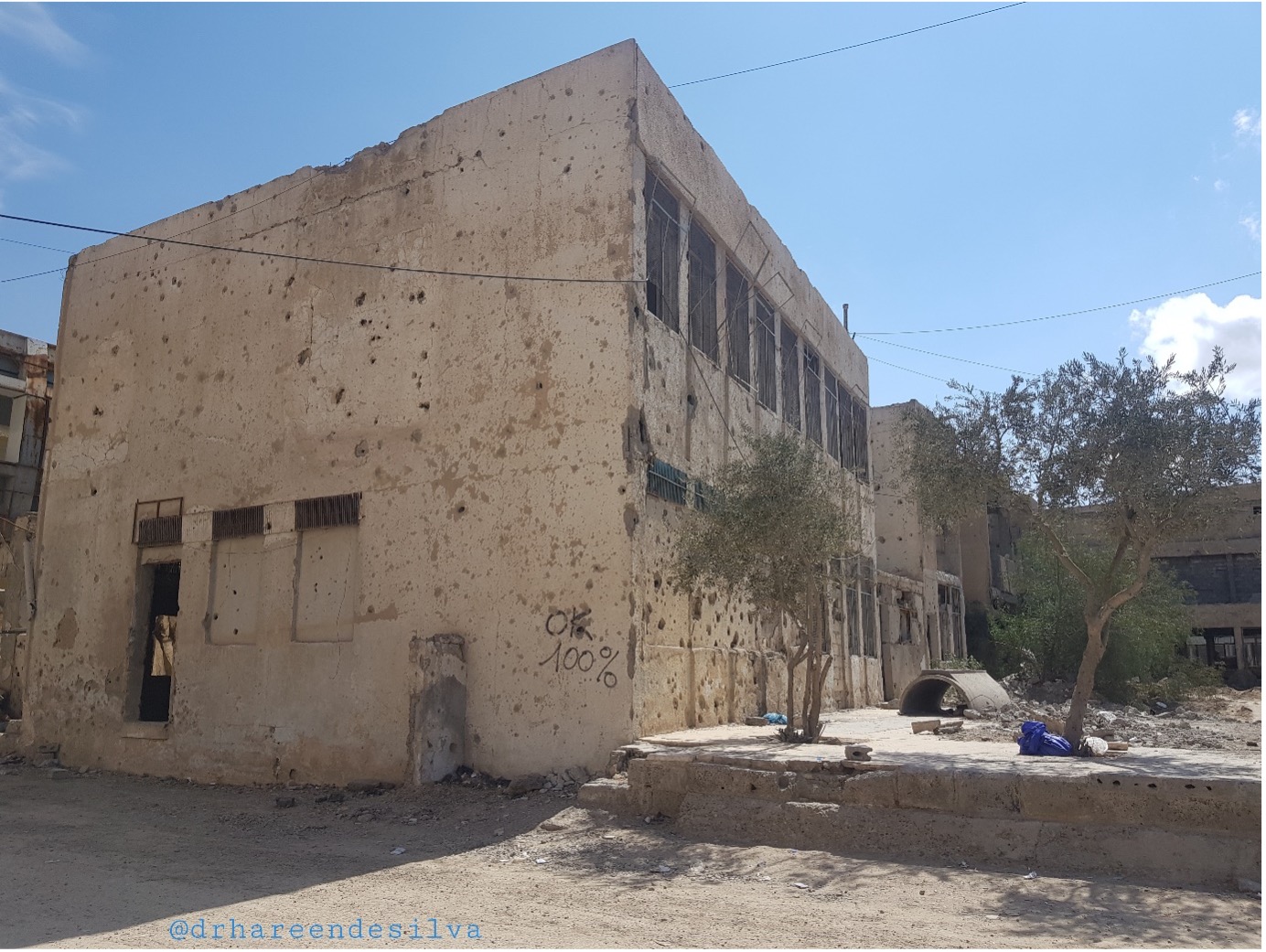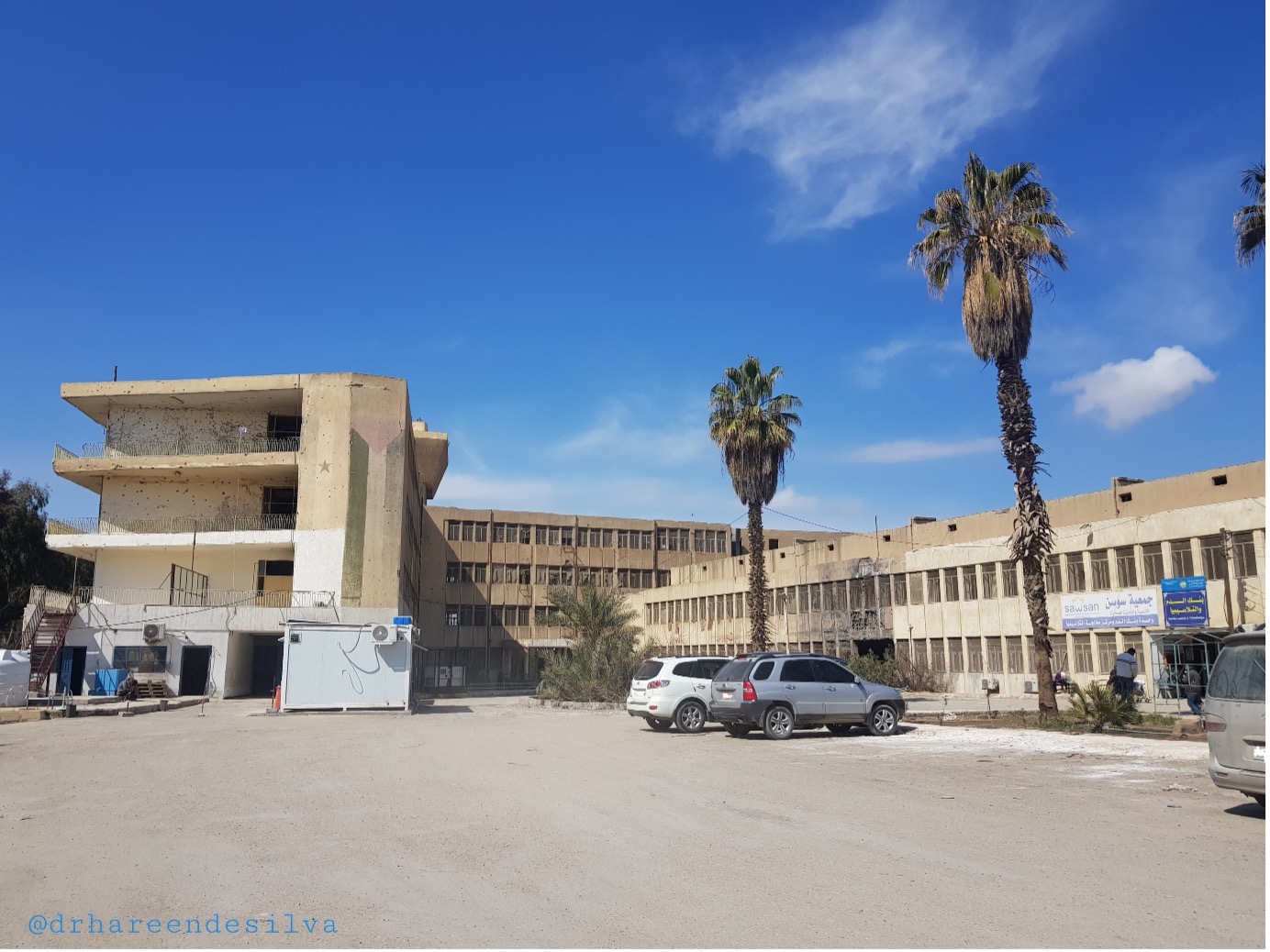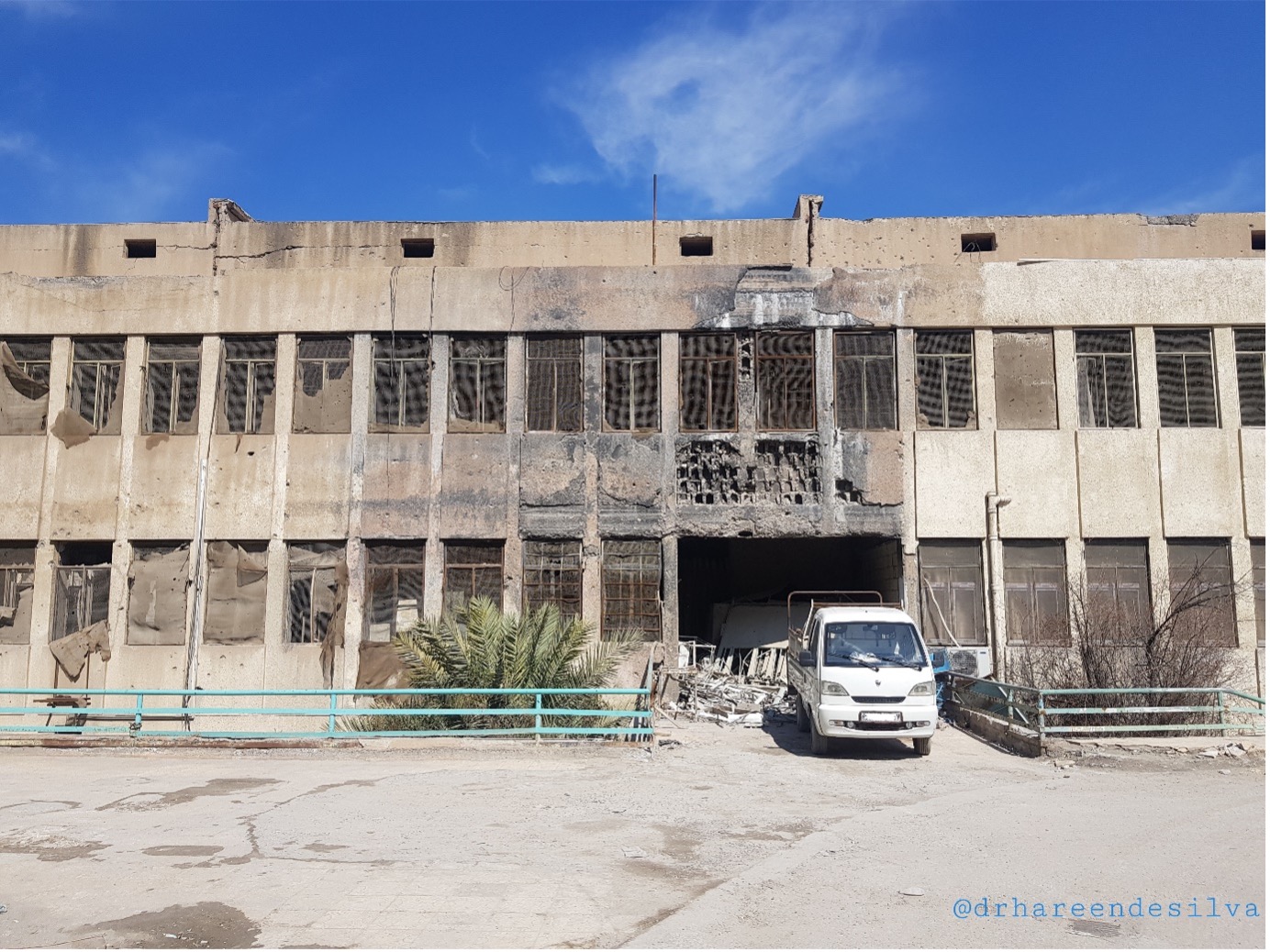 Hareen De Silva BEM qualified as a GP in the UK but is currently living in Syria and Iraq working as the Medical Coordinator for The Middle East for a German international NGO called CADUS e.V., overseeing all the healthcare projects the NGO has in Iraq and Syria. He is on Twitter: @drhareendesilva
Hareen De Silva BEM qualified as a GP in the UK but is currently living in Syria and Iraq working as the Medical Coordinator for The Middle East for a German international NGO called CADUS e.V., overseeing all the healthcare projects the NGO has in Iraq and Syria. He is on Twitter: @drhareendesilva
With attacks on health care in Ukraine increasing there has been comparisons drawn to the tactics used by Russia in Syria, dubbed the ‘Syrian Playbook’.1
Over the 11-year civil war in Syria, there have been over 600 attacks on health care during conflict (AHCC).2 One such healthcare facility that was attacked in Syria was the Raqqa National Hospital (pictured), which was damaged during airstrikes that decommissioned the dialysis unit, adult, and neonatal intensive therapy unit.3 Currently it is not fully functioning, relying on services being provided in conjunction with international non-governmental organisations to serve a population of 393 512 people.4
With destruction of health facilities during conflict there is a reduction in vital services to the population, leading to a lack of emergency care in the acute phase of war and then ultimately poorly treated non-communicable diseases, leading to chronic ill-health or disability.

Currently there are 21.7 million people living in Syria, and 14.6 million are classified as being in need for humanitarian assistance (PiN).4 Coupled with this, there are only 65% of hospitals and 56% of primary healthcare facilities functioning in Syria.4 In terms of staffing there are only 3754 midwives, 30 327 nurses (1.4 per 1000), and 18 314 doctors (0.8 per 1000) spread across those facilities in 2021.5,6 In comparison to the UK in 2019, for a population of approximately 67 000 000 there were 5.8 doctors and 10.3 nurses and midwives per 1000 people working in the NHS.7 The erosion of the health system in Syria has led to only:5
• 1% of facilities Syria being able to offer cancer diagnosis and treatment;
• 4% of facilities offering renal dialysis facilities;
• 5% of facilities offering physical rehabilitation; and
• 42% of facilities offering mental health services.
The health of the nation is expected to decline, with drivers such as socioeconomic factors and food security playing their part. Currently 90% of people live below the poverty line in Syria,8 with 20% of those aged <5 years acutely or chronically malnourished and 54% of the total population food insecure.8 This is all with the possibility of famine predicted in 2022 before the war in Ukraine began.9
The Middle East and Northern Africa (MENA) region imports 50% of its wheat from Russia and Ukraine, and with soaring wheat prices and disrupted supply chain issues this will impact feeding the population of the region that hosts some of the largest humanitarian crises in the world,10 and of course impact feeding the people of Ukraine.

Russia entered the Syrian Civil War in 2015 and was implicated in attacks on various civilian infrastructures that included schools, healthcare facilities, and markets, which is currently being seen in Ukraine.1 With the attacks on healthcare centres and loss of staff, the Syrian healthcare situation has become dire. With each day the war between Ukraine and Russia continues the health of Ukrainians continues to deteriorate due to issues that have been seen in Syria before.
As of day 70 of the Ukraine–Russia war there have been 186 AHCC, according to the World Health Organization External Situation Report published on 5 May.11 The war itself has produced 15.7 million PiN,12 and that is predicted to increase as time moves on. A swift resolution of the war is what is needed for Ukraine otherwise the health care of the nation will falter with each healthcare worker killed or becoming a refugee, and with each facility becoming damaged.
Ukraine is starting from a better position than Syria with 1640 hospitals, which means it has a larger health sector compared to other countries in the region with 4.2 hospitals per 1 000 000 population, compared to the UKs 2.9 hospitals per 1 000 000 population.6 One issue is that staffing levels have decreased in Ukraine hospitals over time due to migration and retirement, which will be further exacerbated by the war as was seen in Syria. As of 2014, there were 6.7 nurses and 3.0 doctors per 1000 population.13
The effects of the war in Syria on health care is obvious to see from the figures above, and the longer the war in Ukraine continues there is the possibility that health care suffers in the long term, as it has done in Syria.
References
1. Graham-Harrison E, Dyke J. How Russia is using tactics from the Syrian playbook in Ukraine. The Guardian 2022; 24 Mar: https://www.theguardian.com/world/2022/mar/24/how-russia-is-using-tactics-from-the-syrian-playbook-in-ukraine (accessed 20 May 2022).
2. Ekzayez A. Attacks on healthcare in the Syrian conflict: drawing lessons from Syria to improve global reporting systems. 2021. https://www.chathamhouse.org/2021/11/attacks-healthcare-syrian-conflict (accessed 20 May 2022).
3. Physicians For Human Rights. Illegal attacks on health care in Syria. 2022. https://syriamap.phr.org/#/en (accessed 20 May 2022).
4. United Nations Office for the Coordination of Humanitarian Affairs, Humanitarian Response, Humanitarian Insight, Financial Tracking Service. Humanitarian needs overview: Syrian Arab Republic. 2022. https://reliefweb.int/report/syrian-arab-republic/2022-humanitarian-needs-overview-syrian-arab-republic-february-2022 (accessed 20 May 2022).
5. Health Cluster, World Health Organization. Snapshot on WoS Health Resources and Service Availability Monitoring System (HeRAMS) 2021 Q3: Jul-Sep. 2021. https://www.humanitarianresponse.info/sites/www.humanitarianresponse.info/files/documents/files/wos_herams_q3_2021_final_0.pdf (accessed 20 May 2022).
6. World Health Organization. Situation assessment of rehabilitation in Ukraine. 2021. https://apps.who.int/iris/bitstream/handle/10665/349595/9789289056304-eng.pdf (accessed 20 May 2022).
7. Organisation for Economic Co-operation and Development. Physicians (per 1,000 people) — United Kingdom. 2019. https://data.worldbank.org/indicator/SH.MED.PHYS.ZS?locations=GB (accessed 23 May 2022).
8. UNICEF. Fast facts: children and the Syria regional crisis 11 years on. 2022. https://reliefweb.int/report/syrian-arab-republic/fast-facts-children-and-syria-regional-crisis-11-years-enar (accessed 20 May 2022).
9. Center for Operational Analysis and Research. Syria in 2022: new aid approaches for an evolving crisis. 2022. https://reliefweb.int/report/syrian-arab-republic/syria-2022-new-aid-approaches-evolving-crisis (accessed 20 May 2022).
10. CARE. The hunger clock is ticking across the Middle East and North Africa: three weeks into the Ukraine conflict, people are already feeling the impact. 2022. https://www.care.org/news-and-stories/press-releases/the-hunger-clock-is-ticking-across-the-middle-east-and-north-africa-three-weeks-into-the-ukraine-conflict-people-are-already-feeling-the-impact (accessed 20 May 2022).
11. World Health Organization. Emergency in Ukraine: External Situation Report #10, published 5 May 2022. 2022. https://reliefweb.int/report/ukraine/ukraine-humanitarian-impact-situation-report-1200-pm-eet-26-april-2022 (accessed 23 May 2022).
12. United Nations Office for the Coordination of Humanitarian Affairs. Ukraine: Situation Report, 6 May 2022. 2022. https://www.gov.uk/government/news/record-number-of-nhs-doctors-and-nurses-in-england (accessed 23 May 2022).
13. Organisation for Economic Co-operation and Development. Nurses and midwives (per 1,000 people) — Ukraine. 2014. https://data.worldbank.org/indicator/SH.MED.NUMW.P3?locations=UA (accessed 23 May 2022).
Featured photo of Ward building at Raqqa National Hospital by Hareen De Silva BEM.






